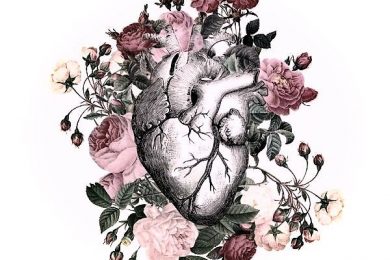Last November, the final
petal
curled its softness into bone
(and my mouth tasted bruised for weeks).
Death has a name that sounds
like silk sliding over the ground,
but she is not so soft:
I have been watching my grandmother’s
body harden for years,
the flower unfolding itself,
petals
falling and winding
into skin so tight it could be broken
with the brush of a fingernail,
unmoving, limbs like veined stems
trapped in hoar frost,
imprisoned by her own flesh and blood
(this is what a woman dying
of cerebellar degeneration looks like).
I always thought my grandmother
looked astonishingly like a
corpse
all empty eyes and cold hands with
blue vessels rising to the surface of her skin
like drowned spider web veins,
and when she finally ran out of heartbeats –
flowerhead empty,
petals
dried and withered –
I remember thinking that in Death
wearing the mortician’s powders
she looked more alive
then when she had been plucking breaths
one by one from between her lips:
I never saw the blooming,
(only the withering)
so when the
petals
fell scattered at my feet
I gathered them into posies –
a shard of skin,
a section of skull,
a sliver of spine:
this was the anatomy of her loss,
(after all, I never knew her to be more
than a body strained by disease).
They brought us flowers and condolence notes,
bouquets of lilies and carnations,
women in pale gloves and taffeta skirts
wearing ornamental tears on their cheekbones,
breathing in Death
like it was a fine perfume,
women who weren’t there to see her hardening
but were somehow greatly affected
by her tragedy
and all the while I could only sit, plucking
petals
from the white lilies,
(she loves me, she loves me not),
learning grief is a thing of
wilting and falling and crumbling
petal
by
petal,
until we lose ourselves in loss.







